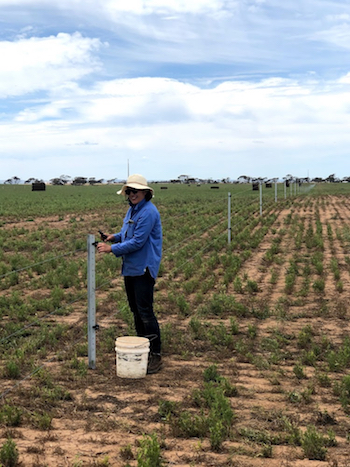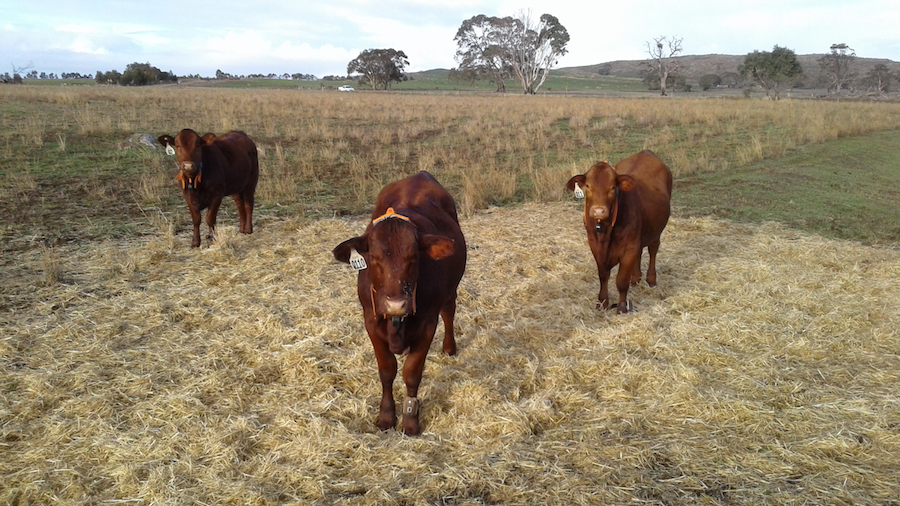Novel research is examining the performance of virtual fencing technology as a farm automation tool that uses livestock grazing for targeted weed control and to minimise grazing impacts on grain crops, ground cover and erosion-prone areas.
CSIRO group leader for integrated agricultural systems Dr Rick Llewellyn and CSIRO animal behaviour and welfare team leader Dr Caroline Lee are co-leading the study with GRDC and Australian Wool Innovation co-investment.
 Dr Caroline Lee from CSIRO co-leads the research pushing the boundaries of virtual fencing technology for cattle and sheep. Photo: CSIRO
Dr Caroline Lee from CSIRO co-leads the research pushing the boundaries of virtual fencing technology for cattle and sheep. Photo: CSIRO
Dr Llewellyn, who is based at CSIRO’s Waite Campus in Adelaide, says the technology has attracted enormous interest from mixed farmers, particularly those seeking to better manage grazing and ground cover across increasingly large cropping paddocks.
“One of the attractions for growers is the potential for targeted grazing to more effectively manage weed populations in mixed-farming rotations,” Dr Llewellyn says.
The technology uses automated GPS-enabled, solar-powered neckband devices to train cattle to stay within a virtually fenced boundary using audio cues.
“Animals receive audio cues via a neckband device that indicates where the virtual fenceline is positioned,” he says.
“To train the animals, a mild pulse is also administered if the animals ignore the initial audio cue and continue to move towards the virtual fence.
“It is remarkable how quickly the animals learn to respond to the audio cue alone.”
The paddock set up for this technology, which is linked to a satellite base station, cloud-based data storage and an app (web and tablet), is being commercialised by Melbourne-based agricultural tech company Agersens using patents developed at CSIRO.
CSIRO scientists are also in the early stages of developing a prototype that adapts the virtual fencing technology to sheep using an eartag device, instead of the neckband device fitted to cattle.
Neckbands were found be unviable for sheep due to the insulating properties of wool and its growth rate.
To test the efficacy of these systems for both cattle and sheep, five trials are planned on mixed farms across South Australia as part of the three-year project before it concludes in 2022.
The first of these trials, which ran from October to November last year, examined the effects of ‘zonal grazing’ cattle on a grower’s property at Long Plains, north of Adelaide, using Agersens’ eShepherd® livestock management system.
The CSIRO research team monitored the impacts of the system on weed populations and ground cover where 40 head of cattle grazed paddocks of vetch after it was cut for hay. Regrowth of the vetch and weeds including ryegrass and sow thistle was substantial following significant rainfall.
Half of the animals strip-grazed a paddock with virtual fencing and the other half grazed another paddock without virtual fencing.
Scientists shifted the virtual fenceline over the surface of the paddock three times, effectively creating four different paddock zones for strip-grazing.

Cattle fitted with automated GPS-enabled, solar-powered neckband devices that train the animals to stay within a virtually fenced boundary using audio cues. Photo: CSIRO
Dr Llewellyn says the trial aimed to use virtual fencing to increase grazing pressure on weed populations, particularly ryegrass, to reduce weed seed production in paddock zones defined by the virtual fencelines.
“The eShepherd® technology performed well and effectively fully contained the young cattle in the paddock zones established by the three fenceline shifts,” he says.
“The ability to strip-graze, targeting particular weedy areas of a paddock, is a potential benefit of virtual fencing that could see farmers increase grazing pressure to reduce weed seed set and also manage ground cover in fragile areas."
“Preliminary results from the trial show strip-grazing using virtual fencing more than halved the amount of ryegrass seed heads compared to the paddock grazed without virtual fencing, and there was no significant difference in cattle live weight gain over the two-week trial.”
The CSIRO team will also examine weed populations and crop performance when the grazed vetch paddocks are sown to wheat next year.
Another trial planned in autumn aims to examine the effectiveness of virtual fencing for managing early season zonal grazing of cattle in a dual-purpose cereal crop to optimise ground cover, weed control and crop yield potential.
“Following the cattle trials, the project’s on-farm trial program will study the potential for virtual fencing to be applied to targeted sheep grazing for winter and summer weed control,” Dr Llewellyn says.
New technology shows paddock management potential

Dr Rick Llewellyn says virtual fencing technology effectively protected a watercourse area containing eucalyptus saplings from being grazed on a commercial farm. Photo: CSIRO
An experimental trial at Eden Valley, north-east of Adelaide, South Australia, has highlighted the potential for virtual fencing technology to protect fragile and environmentally sensitive farm areas.
The on-farm trial tested the performance of a pre-commercial version of the eShepherd® virtual fencing livestock management system developed by agricultural tech company Agersens in a 14-hectare lucerne paddock in May last year.
Beef cattle were trained to graze the paddock within virtually fenced boundaries with audio and electrical cues administered by automated GPS-enabled neckbands fitted to the livestock as part of the eShepherd® system.
CSIRO group leader for integrated agricultural systems Dr Rick Llewellyn co-led the trial with co-investment from the South Australian Murray–Darling Basin Natural Resources Management (NRM) Board and Adelaide and Mount Lofty Ranges NRM Board.
“South Australia’s first virtual fencing trial with cattle has demonstrated the technology’s potential to deliver significant management and environmental benefits," Dr Llewellyn says.
“The trial successfully protected a watercourse area containing eucalyptus saplings from being grazed on a commercial farm.”
To achieve this result, the CSIRO research team applied the prototype neckband devices to 20 Santa Gertrudis heifers for the 44-day trial. The system was then applied to establish a contoured virtual fenceline in the paddock to prevent the cattle from grazing the watercourse area.
Dr Llewellyn says it was one of the first virtual fencing trials showing animals can be trained quickly to respond to a contoured virtual fenceline.

Cattle were quickly trained to respond to a contoured virtual fenceline in a paddock trial on a farm at Eden Valley, South Australia. Photo: CSIRO
This contoured approach could allow farmers to virtually fence different soil types for zonal or strip-grazing in paddocks, he says.
“The cattle were prevented from grazing the exclusion zone containing the saplings for 99.8 per cent of the trial period.”
CSIRO scientists also mapped and analysed the availability and quality of pasture feed in paddock areas where virtual fencing was used to manage cattle grazing (inclusion zone) compared with areas where grazing was excluded (exclusion zone).
“At the end of the trial, pasture feed available in the grazing exclusion zone, measuring 0.59 tonnes per hectare, was nearly double the amount of feed in the grazing inclusion zone, measuring 0.31t/ha.
“So towards the end of the 44-day trial period, there was plenty of incentive for the animals to try to cross the virtually fenced boundaries.”
Overall, Dr Llewellyn says, the findings suggest virtual fencing could also provide important natural resource management benefits.
For instance, the technology might be used to exclude livestock from waterlogged or fragile soils, reduce overgrazing and erosion, and maintain optimal ground cover.
More information: Rick Llewellyn, 0429 690 861, rick.llewellyn@csiro.au

























































